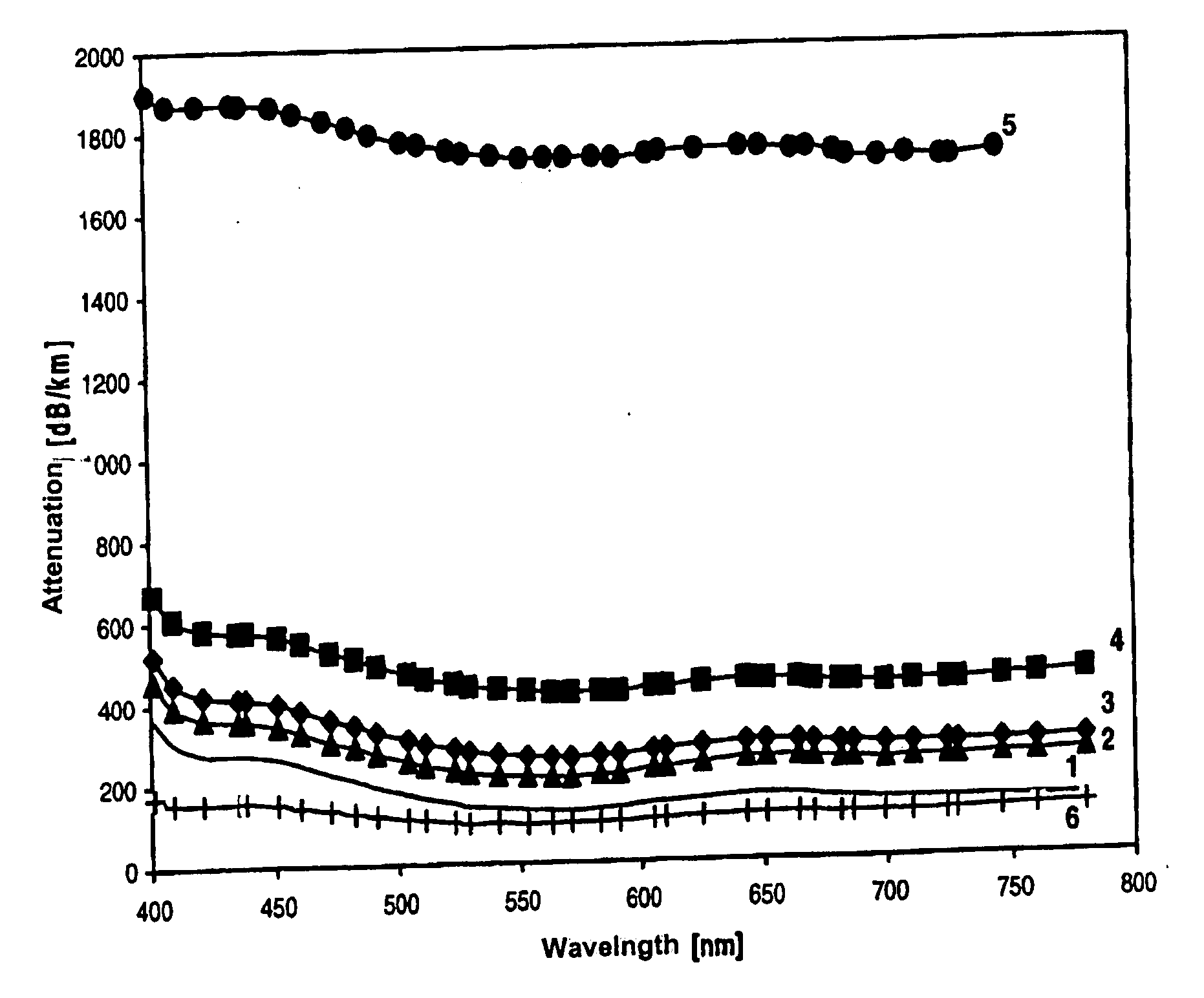Optical fibers made from multicomponent glass
a technology of optical fibers and glass, applied in the direction of clad optical fibres, glass making apparatus, instruments, etc., can solve the problems of high raw materials for melting this type of core glass, significant manufacturing costs of these fibers and/or light guides, and noticeable yellow tint of light exiting from light guides
- Summary
- Abstract
- Description
- Claims
- Application Information
AI Technical Summary
Benefits of technology
Problems solved by technology
Method used
Image
Examples
embodiment 1
[0060] In a first series of experiments different varieties of core glass were drawn to form optical fibers with only one cladding glass, the alkali borosilicate glass according to Table II, cladding glass embodiment 1, which has proven to be especially advantageous. The results for the optical fiber made in these experiments for a total number of 8 trial core glass compositions are tabulated in Table I.
[0061] For the case of an optical fiber required to have a numerical aperture NA≧0.50, core glass embodiment 1 has the absolutely lowest attenuation level (80 dB / km at 553 nm when the raw materials employed have very high purity). It contains only 3.5% PbO and had a numerical aperture of 0.522 with the alkali borosilicate glass type 1.
[0062] Core glass compositions with lower PbO content, e.g. 1.3%, have poorer attenuation and exhibit starting crystallization. When the PbO content is greater than 3.5% indeed good drawability is guaranteed (core glass embodiments 3 and 4), generally ...
first embodiment
[0068] The last column of Table I includes the glass composition of a conventional light flint glass with very good transmission with associated attenuation values. Table I shows that the first embodiment according to the invention has an attenuation that is almost about a factor of 3 less than the attenuation of the light flint glass of the prior art, almost the same numerical aperture NA, but a factor of 10 less PbO content.
embodiment 8
[0069] Even the lead-free embodiment 8 of Table I still has a factor of greater than 2 less attenuation than that of the conventional flint glass at 553 nm. In practical applications this means that the optical fiber made from the core glass / cladding glass compositions according to the invention can transmit light over more than twice to three times the distance that a conventional optical fiber made with the light flint glass can.
[0070] Conversely the cross-sectional area of a light guide transmitting light can be reduced for the same transmission distance and the same total intensity of transmitted light when the optical fibers according to the invention with the lower attenuation are used.
[0071] An example for the case of an optimum core glass embodiment 1 (see Table I, 80 dB / km) in comparison to conventional light flint glass (see last column, 226 dB / km) for a wavelength λ=553 and a transmission distance of 20 m should illustrate this latter result. In this case only half the b...
PUM
| Property | Measurement | Unit |
|---|---|---|
| distances | aaaaa | aaaaa |
| distances | aaaaa | aaaaa |
| outer diameter | aaaaa | aaaaa |
Abstract
Description
Claims
Application Information
 Login to View More
Login to View More - R&D
- Intellectual Property
- Life Sciences
- Materials
- Tech Scout
- Unparalleled Data Quality
- Higher Quality Content
- 60% Fewer Hallucinations
Browse by: Latest US Patents, China's latest patents, Technical Efficacy Thesaurus, Application Domain, Technology Topic, Popular Technical Reports.
© 2025 PatSnap. All rights reserved.Legal|Privacy policy|Modern Slavery Act Transparency Statement|Sitemap|About US| Contact US: help@patsnap.com

